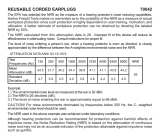
E•A•RLog® is a registered trademark of Aearo Company. Copyright 1996. First printing 1987
LIT. CODE 30310 2/99 AG
earmold fabrication. He suggested that
the primary reason for the reduced at-
tenuation "was related to sound pass-
ing through leaks around the traditional
earmolds."
5
Thus, depending upon the
impression and fabrication procedures,
even unvented earmolds may fail to
provide adequate noise attenuation.
Discussion
The data in this report indicate that for
the typical vented earmold, and even
unvented earmolds depending upon
how they were fabricated, attenuation
is insufficient for all but the most mar-
ginal occupational exposures. However
for a tightly fitted unvented earmold or
when foam earplugs are used as hear-
ing aid earmolds, protection equivalent
to standard commercially available ear-
plugs is achievable. If possible, it is best
to validate the level of protection by
asking the audiologist who fitted the
hearing aid to estimate its attenuation
using sound field audiometry, i.e. mea-
suring the difference between the
individual's unaided, unoccluded
thresholds and the occluded thresholds
with the aid turned off.
Related Issues
Regardless of the amount of attenua-
tion that is provided by the hearing aid
earmold, the aid itself, which usually
supplies from 20 to 50 dB of maximum
gain, can potentially cause additional
noise-induced hearing loss when used
in the presence of sustained high-level
noise.
7
Although no definitive answers
are available, a prudent recommenda-
tion is that employees should never
operate their aids without the addition
of an earmuff (see below) when the
sound levels exceed 80 dBA. Whenever
hearing aids are worn in noise, careful
employee orientation is necessary, and
more frequent audiometric monitoring
(twice annually) is advised until the sta-
bility of the individual's hearing thresh-
old levels can be verified.
When a hearing aid user is required to
remove his or her aid and wear a hear-
ing protector, speech messages and
some warning signals may be attenu-
ated below the hearing threshold. This
effect may be minimized by providing a
low-attenuation HPD, one with the mini-
mum attenuation necessary for the ex-
posures in question. Individual coun-
seling is required as well as evaluation
of the suitability of the person for the
job. For example, in the Air Force mini-
mum hearing sensitivity is specified for
certain noise-hazardous occupations.
8
Alternative strategies, but ones that
should only be
considered with cau-
tion
, involve the use of hearing aids (pri-
marily ITE versions) worn under ear-
muffs. Presuming the earmuff is in good
condition and properly worn, in certain
cases the aid may be adjusted (for re-
duced gain) to partially compensate for
the predominantly high-frequency hear-
ing deficit arising from the combination
of sensory loss and earmuff attenua-
tion.
9
The aid may also be used under
the earmuff in a
non
operational mode,
but if the earmold is well fit and has mini-
mal venting, the combined attenuation
from the two devices can be great
enough to render the already hearing-
impaired individuals unable to hear the
sounds about them.
Whatever decision is made concerning
the suitability of the earmold for use as
a hearing protector, the hearing-im-
paired individual should be protected.
Exceptions may include an individual
with a hearing loss so severe that the
noise is inaudible, or persons with a
conductive loss that exceeds in magni-
tude the attenuation that a hearing pro-
tector could provide.
10,11,12
Decisions regarding the disposition of
hearing-aid users and others with sub-
stantial hearing impairments are not
clear cut. Even with individual counsel-
ing, comprehensive audiological
workups, and expert consultation, ideal
solutions are elusive. Development of
an informed consensus on suitable
strategies for protecting the already
hearing impaired awaits further labo-
ratory and field research as well as
frank and open scientific exchange.
Your comments and/or case histories
are invited and welcome.
References and Footnotes
1. Gasaway, D.C.(1985).
Hearing Conservation-A Practical
Manual and Guide
, Prentice-Hall, Inc., Englewood Cliffs,
NJ.
2. Killion, M.C. (1985). "The Noise Problem: There's Hope."
Hearing Instr. 36 (11), 26-32.
3. Berger, E.H. - The EARLog Series is available upon re-
quest from Aearo Company.
4. ANSI (1984). "Method for the Measurement of the Real-Ear
Attenuation of Hearing Protectors," American National
Standards Institute, S12.6-1984, New York, NY.
5. Frank, T. (1980). "Attenuation Characteristics of Hearing
Aid Earmolds, " Ear and Hearing 1( 3), 161-166.
6. Berger, E.H. (1986). "Hearing Protection Devices," in
Noise
and Hearing Conservation Manual, Fourth Edition
edited by
E.H. Berger, W.D. Ward, J.C. Morrill, and L.H. Royster,
Am. Ind. Hyg. Assoc., Akron, OH, 319-381.
7. Humes, L.E. and Bess, E.H. (1981). "Tutorial - On the
Potential Deterioration in Hearing Due to Hearing Aid
Usage," J. Speech Hear. Res. 24 (1), 3-15.
8. U.S. Air Force regulation AFR 160-43, attachment 3,
Washington, DC.
9. Killion, M.C. (1986). Personal communication based upon
theoretical considerations.
10. Dobie, R. (1986). Personal communication.
11. Sataloff, R.T. (1984), "Knowledge of Hearing Aids Benefits
Safety and Health Team," Occup. Health Saf. 53 (3), 38-41.
12. OSHA published regulations do not permit such excep-
tions, but according to J. Barry (Tech Support IH in OSHA
Region#3) special cases can be discussed with area direc-
tors.
MODIFIED vs. UNMODIFIED
FOAM EARPLUG
FREQUENCY (kHz)
0
10
20
30
40
50
0
10
20
REAL-EAR ATTENUATION (dB)
STANDARD DEVIATION (dB)
.125 .250 .500 1.0 2.0 3.15 4.0 6.3 8.0
E-A-R Plug
Figure 2
STD. DEV.
MEAN ATTN.
¨
E-A-R Plug w/tube + BTE aid
¨
COMPARATIVE DATA
FREQUENCY (kHz)
-10
0
10
20
30
40
0
10
20
REAL-EAR ATTENUATION (dB)
STANDARD DEVIATION (dB)
.125 .250 .500 1.0 2.0 3.15 4.0 6.3 8.0
Silicone-earmold hearing protector 16
Avg. of 3 unvented earmolds (this study) 11
Avg. of 6 unvented earmolds (Frank ) 2
Figure 3
NRR
STD. DEV.
MEAN ATTN.
5






